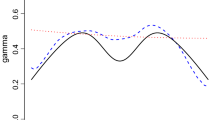Abstract
In Beirlant et al. (1999) and Feuerverger and Hall (1999) an exponential regression model (ERM) was introduced on the basis of scaled log-spacings between subsequent extreme order statistics from a Pareto-type distribution. This lead to the construction of new bias-corrected estimators for the tail index. In this note, under quite general conditions, asymptotic justification for this regression model is given as well as for resulting tail index estimators. Also, we discuss diagnostic methods for adaptive selection of the threshold when using the Hill (1975) estimator which follow from the ERM approach. We show how the diagnostic presented in Guillou and Hall (2001) is linked to the ERM, while a new proposal is suggested. We also provide some small sample comparisons with other existing methods.
Similar content being viewed by others
References
Beirlant, J., Dierckx, G., Goegebeur, Y., and Matthys, G., “Tail index estimation and an exponential regression model,” Extremes 2, 177–200, (1999).
Beirlant, J., Vynckier, P., and Teugels, J.L., “Tail index estimation, Pareto quantile plots, and regression diagnostics,” J. Amer. Statist. Assoc. 91, 1659–1667, (1996).
Box, G.E.P. and Tidwell, P.W., “Transformation of the independent variables,” Technometrics 4, 531–550, (1962).
Csörgő, S., Deheuvels, P., and Mason, D., “Kernel estimates of the tail index of a distribution,” Ann. Statist. 13, 1050–1077, (1985).
Csörgő, S. and Viharos, L., “Estimating the tail index.” In: Asymptotic Methods in Probability and Statistics (B. Szyszkowicz, ed.) North-Holland, Amsterdam, 833–881, (1998).
Danielsson, J.L., de Haan, L., Peng, L., and de Vries, C.G., “Using a bootstrap method to choose the sample fraction in tail index estimation,” J. Multivariate Anal. 76, 226–248, (2001).
Dekkers, A.L.M., Einmahl, J.H.J., and de Haan, L., “A moment estimator for the index of an extreme-value distribution,” Ann. Statist. 17, 1833–1855, (1989).
Drees, H., de Haan, L., and Resnick, S., “How to make a Hill plot,” Ann. Statist. 28, 254–274, (2000).
Drees, H. and Kaufmann, E., “Selecting the optimal sample fraction in univariate extreme value estimation,” Stoch. Proc. Applications 75, 149–172, (1998).
Feuerverger, A. and Hall, P., “Estimating a tail exponent by modeling departure from a Pareto distribution,” Ann. Statist. 27, 760–781, (1999).
Fraga Alves, M.I., Gomes, M.I., and de Haan, L., “A new class of semi-parametric estimators of the second order parameter,” Notas e Comunicacoes C.E.A.U.L. 4/2001, University of Lisbon, to appear in Portugaliae Mathematica (2003).
Gomes, M.I., de Haan, L., and Peng, L., “Semi-parametric estimation of the second order parameter—asymptotic and finite sample behavior,” Notas e Comunicacoes C.E.A.U.L. 8/2000, University of Lisbon (2000).
Gomes, M.I. and Oliveira, O., “The use of the bootstrap methodology in Statistics of Extremes—choice of the optimal sample fraction,” Extremes 4, 331–358, (2001).
Guillou, A. and Hall, P., “A diagnostic for selecting the threshold in extreme-value analysis,” J. R. Statist. Soc. Ser. B 63, 293–305, (2001).
Hall, P., “On some simple estimates of an exponent of regular variation,” J. Roy. Statist. Soc. Ser. B 44, 37–42, (1982).
Hall, P., “Using the bootstrap to estimate mean squared error and select smoothing parameter in nonparametric problems,” J. Multivariate Anal. 32, 177–203, (1990).
Hall, P. and Welsh, A.H., “Adaptive estimates of parameters of regular variation,” Ann. Statist. 13, 331–341, (1985).
Hill, B.M., “A simple general approach to inference about the tail of a distribution,” Ann. Statist. 3, 1163–1174, (1975).
Kaufmann, E. and Reiss, R.D., “Approximation of the Hill estimator process,” Statist. Probab. Letters 39, 347–354, (1998).
Lehmann, E.L., Theory of Point Estimation, Wiley, New York, 1983.
Matthys, G. and Beirlant, J., Adaptive threshold selection in tail index estimation in Extremes and Integrated Risk Management, Risk Books, Risk Books, 2000.
Shorack, G.R. and Wellner, J.A., Empirical Processes with Applications to Statistics, Wiley, New York, 1986.
Author information
Authors and Affiliations
Rights and permissions
About this article
Cite this article
Beirlant, J., Dierckx, G., Guillou, A. et al. On Exponential Representations of Log-Spacings of Extreme Order Statistics. Extremes 5, 157–180 (2002). https://doi.org/10.1023/A:1022171205129
Issue Date:
DOI: https://doi.org/10.1023/A:1022171205129



